Dance
Robert Battle, artistic director
Alvin Ailey, founder
Judith Jamison, artistic director emerita
Celebrity Series of Boston
Boch Center Wang Theatre
April 28 – May 1, 2022
Mass (2004; Ailey premiere, 2017. Choreographer: Robert Battle; Restaged by Elisa Clark; Music: John Macky; Costumes: Fritz Masten; Lighting design: Burke Wilmore)
Revelations (Choreographer: Alvin Ailey; Music: Traditional; Decor and Costumes: Ves Harper; Lighting: Nicla Cernovitch):
Pilgrim of Sorrow (I Been Buked; Didn’t My Lord Deliver Daniel; Fix Me, Jesus)
Take Me To The Water (Processional/Honor, Honor; Wade In the Water; I Wanna Be Ready)
Move, Members, Move (Sinner Man; The Day is Past and Gone; You May Run On; Rocka My Soul in the Bosom of Abraham)
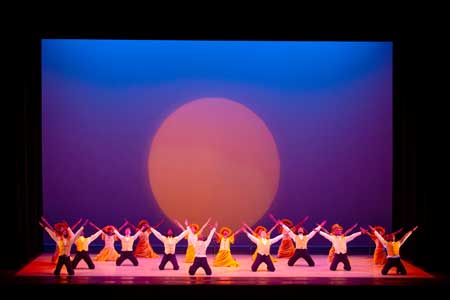
in “Revelations”
Photo: Robert Torres
Courtesy of Celebrity Series of Boston
The Alvin Ailey American Dance Theater roared back into town this week with a tripartite program that conveyed complexity, solemnity and exuberance. Sometimes those themes ran together; sometimes they came in parts. But overall, as a kind of three-movement sonata of gestural forms, they conveyed a novelistic sense of what we have gone through in the past several years.
At the outset, artistic director Robert Battle engaged with the audience, essentially celebrating the return of performance after two years of pandemic and showing regard for the resilient Celebrity Series and its support of the Ailey troupe. In addition to striking a gracefully poignant note about the passing, last fall, of the former Chairman of the Board of the Celebrity Series, Harris Berman – former dean of the Tufts University School of Medicine and former CEO of the Tufts Health Plan – who lent great support to the Ailey troupe over the years, Battle managed to convey humor and charm in addition to grace and poignancy, traits also so evident in the esprit of the fabulous Ailey corps.
Holding Space, which begins the program, provides at the outset a visual and auditory challenge which its ensuing narrative seeks to address: a panel of blaring headlights radiate from the back of the stage as the company erupts into what seems like discombobulated movement. Carrying those along is a musical background which one could only describe as the blaring of horns in a traffic jam. Unpleasant as this may sound, it is not. Indeed, it is jarring and unsettling, but there is a logic to it that becomes evident as the piece unfolds. Gradually, coherence and communication between pairs and then larger groups develop as the music becomes somewhat more thematic. The lights, as well, go down as this evolution takes place, until near the end when they appear in golden yellow, a touch warmer and more sun-like than had appeared before. One imagines the initial individualism and seeming anarchy of the movements as a reflection on the isolationism of the pandemic, and the gradual emergence of form and relationship as a sign, a glimmer of light, as this breakdown begins to heal.
Mass, the middle movement of the evening is clearly an iconic religious piece in some sense, but, extends through movement and gesture towards more universal modes of expression. The main priestly character wears a large angular cross on his chest and the coordinated groping and leaning of the company indicates a complement to the alienated isolationism that opens the program in Holding Space. Here, collectivity is the theme and sanctity its apotheosis. The priestly character does an inspiring dance and the company rises in swoon and shape to answer, indeed like a choral response from an engaged congregation.
Revelations, the signature Ailey piece performed on many occasions by the company over its long history, might be seen as a chestnut, a here-we-go-again moment, were it not so dynamically presented. The work, accompanied in its nine parts by different vocal spirituals, is still, as ever, eloquent and inspiring. The final movement, danced to Rocka My Soul in the Bosom of Abraham, is so sheerly energetic and gleeful that one wants to jump out of one’s seat and join in.
More specific notes on the pieces:
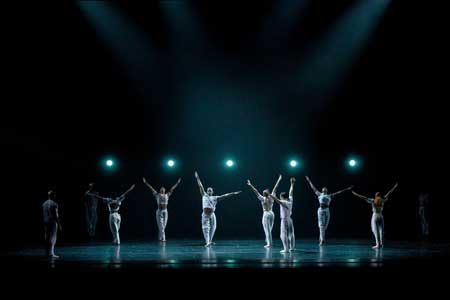
in “Holding Space”
Photo: Robert Torres
Courtesy of Celebrity Series of Boston
Holding Space
Bright headlights, with traffic-like sound, blaring horns, smoke like exhaust. Gyrating forms, out of sync, seeming an apotheosis of frustration, almost hard to watch. (Apparently the piece is inspired by the six-foot rule of the pandemic, requiring each person to hold their space apart from others.) Gradually some developing coordination as the blaring sound maintains. But gradually the sound dies down and rhythmic bells, rather than blaring horns, ensue. A single gyrating form leads off and chiming bells build up in volume as the crowd watches then begins to move in coordination, as though each one were in their own worlds, gradually, like emerging forms, learning to coordinate. The music slows, though still pulsing. Six dancers remain, further exploring in gradual gestures the evolving theme of relationship. A quietly lyrical dance trio flutters, giving the sense of the birth of a butterfly from the prevailingly individualized cocoons. A cube frame is brought forth, almost like a symbol of opening, as a soloist within, edgy and flexible, carves the spaces. The cube circulates around each soloist, as a quieter drone returns with each gyration and transformation. At once, the music – or enveloping sound – stops altogether, yielding to a quiet solo soliloquy, no longer an expression of isolated frustration, but as an emergence of expression and individual form. The headlights in softer sun-like yellow return along with the crowd which now quietly gyrates, yielding a more gracefully calm ensemble. The headlights dim and reglow, then turn white, but now all is calm.
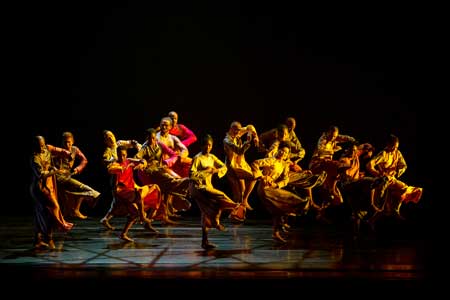
in “Mass”
Photo: Robert Torres
Courtesy of Celebrity Series of Boston
Mass
A lithe and scurrying choir, with vibraphone accompaniment, very energetic, almost seeming like Buddhist monks scurrying around a monastery. But there is a cross, so much more likely these are Christians and this is a Catholic Mass. The assembled come together then move together. Different colors emerge as the vibe chorus ramifies. A beautiful kinetic duo accompanies an acceleration of xylophone brilliance. Dervish-like movements amplify the scurrying. Large and coordinated swaying and gesturing to an energetic and urgent beat; the priest in red swirls and swoons. The line of what – penitents? celebrants? – faces forward before they shape into a testimonial but groping huddle, a kind of singular creature that together reaches for the sky.
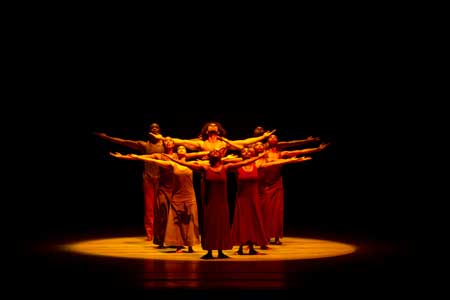
in “Revelations”
Photo: Robert Torres
Courtesy of Celebrity Series of Boston
Revelations
Pilgrim of Sorrow (I Been Buked; Didn’t My Lord Deliver Daniel; Fix Me, Jesus)
I Been Buked
Hymnlike opening. A spiritual choir sedately sets the scene, bending and reaching to earth and sky. There is trouble all over this world, children, a cry of realism in the face of suffering, resiliently calls out a compensatory exuberance. The unit moves so so gracefully together with a culmination of arms and hands breaking open.
Didn’t My Lord Deliver Daniel
More energetic and forceful, a dynamic trio with extensions in multiple dimensions.
Fix Me, Jesus
A quiet hymn once again, and a dance duo, a quiet dual meditation, with beautiful supine elevations, subtly graceful, ending in a wonderful thigh-perched arabesque.
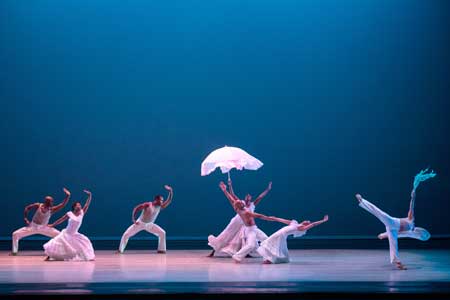
in “Revelations”
Photo: Robert Torres
Courtesy of Celebrity Series of Boston
Take Me To The Water (Processional/Honor, Honor; Wade In the Water; I Wanna Be Ready)
Processional/Honor, Honor
White, all white: gowns, parasols, flags. Walking together and waving flags in a wildly exuberant gospel sway.
Wade In the Water
Blue stretchers precede – it’s the water! And a wonderful trio in white with a dancing parasol unfolds, followed by a beautifully glowing and exuberant duo, with the fleeting of a wild bird at the end.
I Wanna Be Ready
…to put on my long white robe! A quiet dance solo, a private, very dramatic, yogic, meditation.
Move, Members, Move (Sinner Man; The Day is Past and Gone; You May Run On; Rocka My Soul in the Bosom of Abraham)
Sinner Man; The Day is Past and Gone; You May Run On
Oh sinner man, where are you going to run to? A plaintive questioning opening yields to a powerfully rhythmic and driving chorus, with energetic and dramatic male solos in sequence, bringing them forcefully together in the end.
Rocka My Soul in the Bosom of Abraham
A big yellow sun in a red sky. Women in society dresses and fancy hats, doing a lot of furious fanning. They soon cut loose and turn their fans into whirling dervishes. Rocka My Soul takes off as a line of yellow dresses leaves the ground, and the majestically coordinated lines sway and reverberate, turning the stage, and the audience, to exuberant frenzy.
– BADMan (aka Charles Munitz)
Leave a Reply